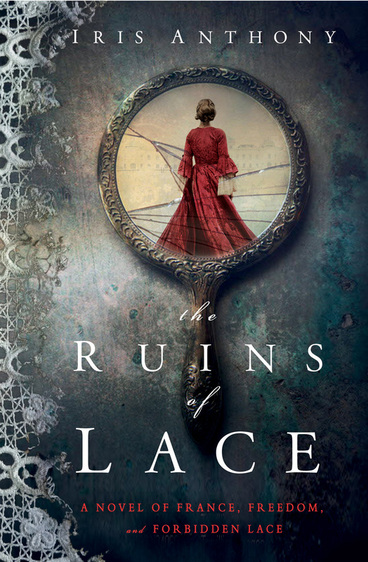
From the publisher:
An enthralling novel centered around the mad French passion for forbidden Flemish bobbin lace in the 1600s, from a writer whose work has been called "unexpected, haunting and powerful" by her readers. For those who want something they don't have, Flemish lace can buy almost anything — or anyone.
I'm pleased to have the author Iris Anthony here to answer a few questions about this fascinating subject.
 When was lace outlawed in France ... and why?
When was lace outlawed in France ... and why?Louis XIII issued five sumptuary edicts that placed prohibitions and restrictions on clothing and on April 3, 1636, he forbid the wearing of lace altogether. That’s the edict which provided for confiscation, fines, and banishment from the kingdom.
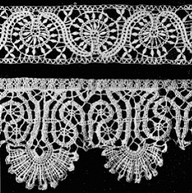
{17th-century bobbin lace.}
Sumptuary edicts were enacted across Europe during this time period. The reasons were several. In France’s case, money was being lost across the border through lace purchases Flanders and Italy at a time when the King desperately needed money to fill his treasury due to expenses from wars and other pet projects. It was hoped that forbidding the wearing of lace would keep all that money in France and, therefore, available to the King.
Another reason is more difficult for our modern minds to understand. Europeans had a great need to keep everyone in their place. Most of these sumptuary edicts were very explicit about who could wear what: Princes of the Blood could wear cloth of gold; other princes were only allowed to wear cloth of silver. Dukes could wear gold lace; earls could only wear gold trim, etc., etc.
Ever since Europeans first started visiting America as ‘tourists’, they’ve been appalled that they couldn’t tell who was who. Since the founding of the U.S., part of being an American was the ‘right’ to purchase what we wanted to and wear the things that we wanted to wear. In Europe, even an extremely wealthy merchant couldn’t wear cloth of silver, for instance, or lace in our case. In the colonial period the sumptuary laws transferred to the New World, but once the U.S. was established as a nation, if you had the money, no one would stop you from buying (and wearing) what you wanted to. These edicts seem very much like quibbling to us, but they were important tools for social control.
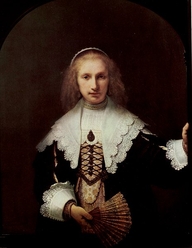
{Lace in the 17th-century.}
Finally, King Louis XIII himself was quite ascetic. He did what he had to in order to be kingly, but he was very austere. He wasn’t into the whole musketeer look (floppy boots, huge hats, big ruffled lace collars).
He was called ‘The Just’ because he really did try to enforce the rules he made (when violations were brought to his attention). He killed the noble who plotted against Richelieu, for instance, in the Chalais Conspiracy. He also executed a court favorite who insisted upon dueling after he had forbidden it.
The King was derailed from his natural penchant for justice when his mother and his brother started conspiring against him, but in general, he wanted order. And he didn’t approve of conspicuous consumption. Obviously, many of those at court did since he kept having to issue sumptuary edicts, but that seemed to be how it went back then just about everywhere.
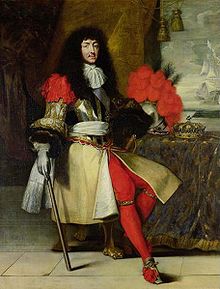
{Portrait of Louis XIV.}
Louis XIV, his son, had a different focus. He loved glitz and glamor. The more of it, the better! He actively encouraged his nobles to partake in lavishness. He wasn’t personally against lace and consumption the way his father had been. He did, however, have a huge need for funding his wars. Colbert (his minister) decided not only to forbid luxury goods in France (as Louis XIII had done), but also encouraged the creation of domestic rip-offs.
For a while, the rip-offs were just that, but eventually, they became even more desired than the foreign goods they had been copied from. The association of France with luxury goods began during Louis XIV’s reign under Colbert’s guiding hand. All of the famous French laces date from that period. The French perfume industry developed then. The glass industry came of age, as did luxury textiles.

{Girls making bobbin lace.}
What was the result of the sumptuary laws?
Like any law, sumptuary laws had unintended consequences. The moment it was forbidden, lace became even more highly prized than it had been. And whenever anything becomes illegal, criminals add it to their list of ways to make money. The result was a surprising paradox: the pairing of ‘smuggling’ and ‘lace’.
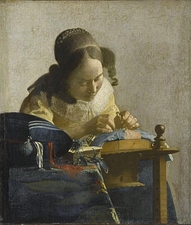
{"The Lacemaker" by Vermeer.}
What were the working conditions like for the lace-makers?
Horrible. Since the lace had to be spotless, lace makers worked their long hours in workshops without heat or light. Fire, in any form, produced soot and ashes which would have soiled the lace. Often workshops were housed beside or above stables so that body heat from animals would keep the lace makers from freezing. Because they worked without light, most lace makers were blind by the age of thirty. Because the work was so tedious, their fingers and backs became crippled and deformed.
You researched this subject extensively. What surprised you?
People and their infinite creativity in finding new ways to maltreat both each other and animals. Whenever I wander through history I’m both amazed and appalled at how similar we are to our forebears.
Thank you, Iris!
The lace illustrations are from Iris's Pinterest board.
I will soon have more on my own blog about Iris's fascinating research and writing processes.
Sandra Gulland
Author of The Josephine B. Trilogy and Mistress of the Sun
=============================================
WEBSITE: http://www.sandragulland.com/
BLOG: http://bit.ly/TheWritingLife
FACEBOOK: http://on.fb.me/SGFBpage
TWITTER: http://twitter.com/Sandra_Gulland
GOODREADS: http://www.goodreads.com/SandraGulland
=============================================